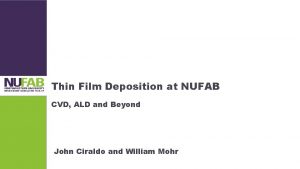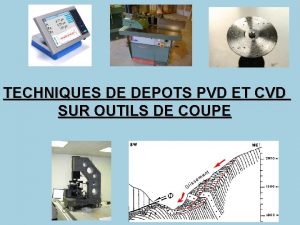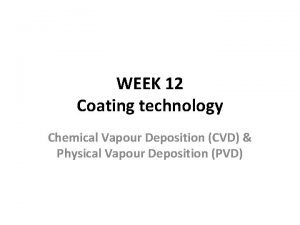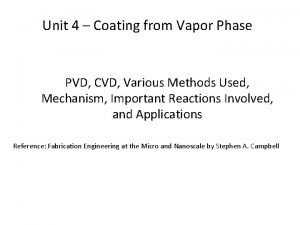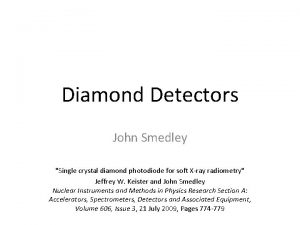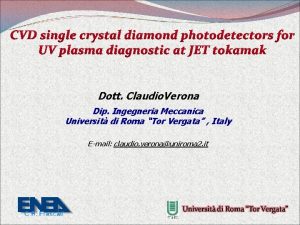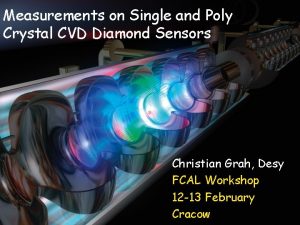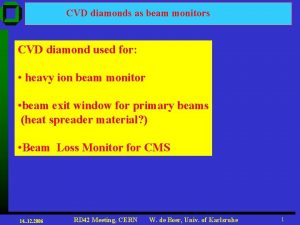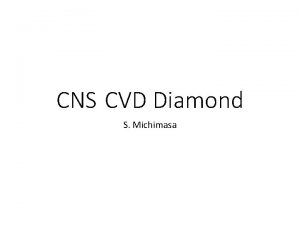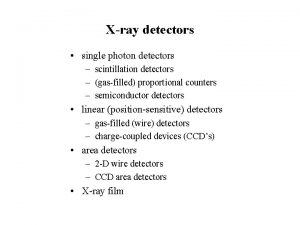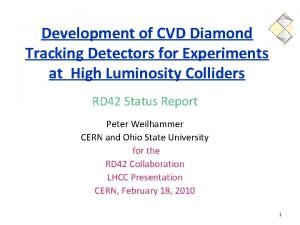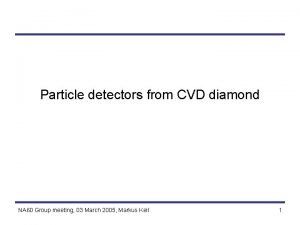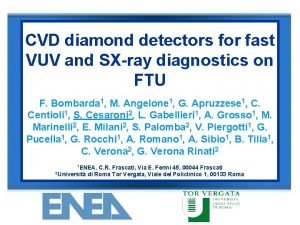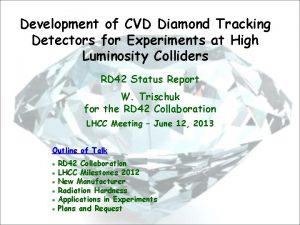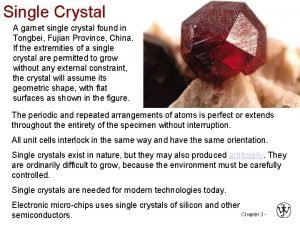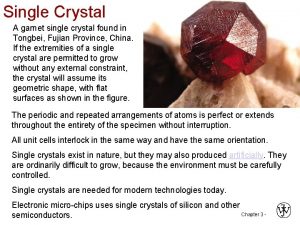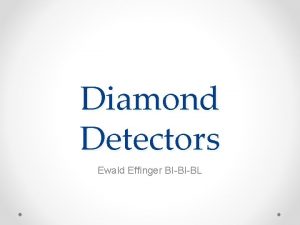SINGLE CRYSTAL CVD DIAMOND DETECTORS Cristina Tuv Department






















- Slides: 22

SINGLE CRYSTAL CVD DIAMOND DETECTORS Cristina Tuvè Department of Physics and Astronomy, University of Catania and INFN Cristina. Tuve@ct. infn. it M. Angelone 1, V. Bellini 4, A. Balducci 2, M. G. Donato 3, G. Faggio 3, M. Marinelli 2, G. Messina 3, E. Milani 2, M. E. Morgada 2, M. Pillon 1, R. Potenza 4, G. Pucella 2, G. Russo 4, S. Santangelo 3, M. Scoccia 2, C. Sutera 4, A. Tucciarone 2, G. Verona‑Rinati 2 1 Associazione EURATOM-ENEA sulla Fusione, Frascati (Roma), Italy 2 Dip. di Ing. Meccanica, University of Roma “Tor Vergata”, Italy 3 Dip. Meccanica dei Materiali, University of Reggio Calabria, Italy 4 Department of Physics, University of Catania ad INFN, Italy RD 05 Conference Florence, October 6 th, 2005

OUTLINE q Diamond films were grown in the Laboratories of Roma “Tor Vergata” University by CVD q Polycristalline CDV diamond - -particle detection - 12 C particle detection at National Southern Laboratories (LNS) in Catania (Italy) - Neutron monitoring at Joint European Torus (JET) in Culham (U. K. ) q Single crystal CVD diamond growth q q Characterization Radiation detectors q Conclusions - -particle detection - Neutron detection RD 05 Conference Florence, October 6 th, 2005

Structural characterization Diamonds are grown in the Laboratories of Roma “Tor Vergata” University by Micro. Wave Plasma Enhanced Chemical Vapor Deposition (MWPECVD) Growth Parameters: Plasma Composition CH 4 / H 2 1% gas mixture Temperature 750 ºC Growth rate 0. 7 m/h Micro-Raman and Micro-PL • FWHM = 2. 4 cm-1, comparable with that of natural mono-crystals (FWHM=2 cm-1) • PL band practically absent (APL/Ap<1/60) M. G. Donato, G. Faggio, G. Messina, S. Santangelo Dip. Meccanica e Materiali Università di Reggio Calabria - Italy RD 05 Conference Florence, October 6 th, 2005

Diamond Detectors Samples showing a very narrow Raman peak and extremely low Particle detection can be used as a very sensitive photoluminescence background can present very different behaviour probe for carrier trapping characterization when used as particle detectors Ionizing particle x h e Au electrode Charge Sensitive Amplifier CVD Diamond p - Si Out Bias Au contact 7 mm 2 wide 100 nm thick Ag contact paint Ag electrode Qc : charge induced for each e-h pair L : detector thickness e : charge of the carriers x : total distance the e and h move apart Ø Efficiency h = QC/Q 0 QC : collected charge Q 0 : total charge The response of the detector is related to the presence of traps Ø Charge Collection Distance (CCD) : d = le + lh = ( e te + h th ) E l : mean drift distance : mobility t : lifetime E : applied electric field RD 05 Conference Florence, October 6 th, 2005

Poly. CVD Diamond detector Effect of pumping Pumping is the procedure to saturate types of defects by means of -particles from 90 Sr. Increased efficiency h and charge colection distance after ioniziong radiation exposure -particle spectra as measured by a policrystalline CVD diamond sample 241 Am • Low energy resolution The dispersion around mean efficiency depends of the fluctuations of the defect density. M. Marinelli et al. Applied Physics Letters 75 (1999) 3216 RD 05 Conference Florence, October 6 th, 2005

-Spectra: Poly. CVD diamond Positive bias – Pumped Negative Polarization _ G h D l e + + Positive Polarization e Negative bias – Pumped h l _ Because h+ > h- lh >> le RD 05 Conference Florence, October 6 th, 2005

LNS - Experimental set-up Target: Au 300 g/cm 2 Beams: 12 C, 6 Li Beam Energy: 12 C: 16÷ 91 Me. V Si detector Beam Faraday cup L. N. S. Tandem accelerator Gold contact Gold target Diamond detectors Vacuum pumps nˆ q Rotating sample holder Incident particles Diamond sample We mounted the samples on a rotating holder. In order that, the penetration depth of the incident particles could vary over a factor of 6. The incidence angle q varied in the 0 o ÷ 80 o range. Combining both the angle and energy scans, the penetration depth can be varied from 2 m to 85 m. RD 05 Conference Florence, October 6 th, 2005

E= 1 V/ m L= 55 m pumped Nuclear particle penetration as probe of defect distribution: results 12 C hit the detector on the growing side in all cases Negative Polarization _ L G h e d + + Positive Polarization e h d _ le = 1/ae = 0. 8 m; lh = 1/ah= 33 m • Defects are concentrated near the substrate side RD 05 Conference Florence, October 6 th, 2005

Grain Boundaries effect model x ü In-grain defects In grain defects: uniformly distributed inside the sample; not dependent on position ü Grain boundaries defects: concentrated at the substrate side; same contribution for both carrier types Grain boundaries defects Electron and hole contributions to the conduction mechanism were successfully separated and evaluated. R. Potenza and C. Tuvè, Carbon: the future for advanced technology applications Springer series Topics in Applied Physics RD 05 Conference Florence, October 6 th, 2005

Neutron detection (JET) Diamond detector installed at Joint European Torus (JET) in a tokamak (Toroidal Kamera Magnitnaya) Monitoring of the 14 Me. V neutrons produced by the D-T plasma during the Trace Tritium Experiment (TTE) lasted 5 weeks CVD Diamond detector count rates Vs Silicon detector ones for all the TTE campaign at JET (5 weeks) Comparison between the temporal response of CVD diamond, Silicon detector and Fission chamber for a JET pulse M. Angelone et al. , Rev. of Sc. Instr 76(2005)013506 üVery similar trend for the three detectors üLower statistic for diamond ØSmaller sensitive volume ØQuite far from the plasma (about 7 m) üGood stability over 5 week of uninterrupted operation RD 05 Conference Florence, October 6 th, 2005

Why would we like to grow CVD diamond on natural diamond ? Poly CVD diamond detectors low stability – low reproducibility It is possible use p. CVDs as counters Dosimeters Beam monitors Neutron flux monitors To proceed towards better energy resolution, we observed that defects concentrate near the substrate on which the growth begins; this can be explained with the fact that Si substrate and diamond crystals have different reticular constants, so that the first shells in the initial growth are not free of defects and produce a columnar growth of the whole diamond deposit. (Heteroepitaxial growth) Low Energy Resolution Diamond: reticular constant: 3. 561 Amg Silicon: reticular constant: 5. 43086 Amg So: we attempted homoepitaxial growth using reactor parameters that optimize heteroepitaxial grown crystals. RD 05 Conference Florence, October 6 th, 2005

Microwave Chemical Vapor Deposition MW -CVD Typical growth parameters Plasma composition Temperature Microwave power Pressure Gas flow rate H 2 -CH 4, CO 2 -CH 4 etc. 650 - 950 °C 600 - 1000 W 50 - 130 mbar 40 - 200 sccm COOLING Substrates ü(100) HPHT (Element 6, Sumitomo, others) üNatural diamond üType Ib, IIa, B-doped RD 05 Conference Florence, October 6 th, 2005

Particle detector üCVD Layer 110 m thick üSubstrate: B-doped HPHT diamond, 315 m thick üCircular Al contacts: 3 mm diameter, 100 nm thick Oscilloscope Ionizing particle Shaping Amplifier Charge h e amplifier CVD diamond HPHT substrate Bias Multichannel analyzer RD 05 Conference Florence, October 6 th, 2005

Comparison between hetero - homoepitaxially grown diamonds: transverse view EM transverse view of a CVD diamond grown on Si substrate (columnar growth of the whole diamond deposit) EM transverse view of a CVD diamond grown on natural diamond substrate RD 05 Conference Florence, October 6 th, 2005

Comparison between hetero-homoepitaxially grown diamonds: surface view EM surface view of a CVD diamond grown on Si substrate CENTER BOUNDARY EM surface view of a CVD diamond grown on natural diamond substrate RD 05 Conference Florence, October 6 th, 2005

X-ray diffraction and Raman spectra üLattice parameter: d=3. 567 Å M. G. Donato, G. Faggio, G. Messina, S. Santangelo Dip. Meccanica e Materiali Università di Reggio Calabria - Italy ü ü ü Micro Raman 514 nm Ar laser Peak @ 1332. 9 cm – 1 FWHM = 1. 8 cm – 1 (including instrum. broadening) ü Extremely low photoluminescence background ü Homogeneous results all over the sample surface RD 05 Conference Florence, October 6 th, 2005

Polycrystal – Single Crystal detectors Poly crystal Single Crystal Diamond üVery poor resolution üStrongly sensitive to “Priming” effect üHigh resolution üNo priming (pumping) effects RD 05 Conference Florence, October 6 th, 2005

Energy resolution and peak energy vs. Voltage q The best resolution is obtained with electric fields E ≈ 1 V/ m q Peak energy saturates at sufficiently high applied voltages RD 05 Conference Florence, October 6 th, 2005

-particles detection Triple source (239 Pu, 241 Am, 244 Cm) emitting 5. 16 Me. V, 5. 48 Me. V and 5. 80 Me. V ‑particles respectively The detector is in the “as grown state” this means that no “priming” procedure was adopted. The same results are observed after 5 krad 90 Sr particle irradiation (i. e. our usual procedure to drive our sample in a fully pumped state). üHigh detection efficiency üHigh resolution ( 1. 1% ) üLow noise üNo pumping effects üGood stability RD 05 Conference Florence, October 6 th, 2005

Frascati Neutron Generator (FNG) Ti – T target θ = 0° Ø D-T fusion reactions neutrons Ø Neutron energy and energy-spread depends on the emission angle with respect to the D beam 260 ke. V Deuterium beam 241 Am θ α-particle source Collimator Diamond detector θ = 90° Neutrons and particles simultaneously irradiated The D-T fusion reactions is simulated inside the neutron transport MCNP code 0° E = 14. 8 Me. V, FWHM = 0. 5 Me. V 90° E = 14. 1 Me. V, FWHM = 0. 3 Me. V RD 05 Conference Florence, October 6 th, 2005

Neutron detection (FNG) Simultaneous neutrons and 241 Am -particle irradiation. Calibration obtained by scaling the horizontal axe with respect to the 241 Am peak üCorrect position of both 0° Position measurement 12 C(n, )9 Be peak E = 9. 1 Me. V FWHM = 0. 5 Me. V 90° Position measurement 12 C(n, )9 Be peak E = 8. 4 Me. V Correct position Same of the incident neutrons FWHM = 0. 3 Me. V RD 05 Conference Florence, October 6 th, 2005

CONCLUSIONS • The reliable use of polycrystalline diamond for neutron detection in fusion experiments has been demonstrated. • High quality single crystal diamond films were homoepitaxially grown by CVD onto HPHT diamond substrates. • Single crystal diamond particle detectors were produced and tested with -particle, and neutrons. • A resolution of 1. 1% (including electronic noise) have been measured when irradiating with -particles. • • No “priming” or “pumping” effect was observed. 14 Me. V Neutron spectra showed a clear 12 C(n, )9 Be peak with a energy resolution lower than 3. 6% (energy spread of the incident neutrons). RD 05 Conference Florence, October 6 th, 2005
 Pvd cvd ald
Pvd cvd ald Pvd
Pvd Pvd vs cvd
Pvd vs cvd Commvault port 8403
Commvault port 8403 Chemical vapour deposition process
Chemical vapour deposition process Abcdefghi lmnopqrstuvwxyz
Abcdefghi lmnopqrstuvwxyz Tuv sud benelux
Tuv sud benelux Tüv
Tüv Https:// www.yout
Https:// www.yout Vhv voltage detectors
Vhv voltage detectors Where are feature detectors located
Where are feature detectors located Giant wave detectors murmurs universe
Giant wave detectors murmurs universe Frontier detectors for frontier physics
Frontier detectors for frontier physics Photo detectors
Photo detectors Kinesthesis and vestibular sense
Kinesthesis and vestibular sense Giant gravitational wave detectors hear murmurs
Giant gravitational wave detectors hear murmurs Photo detectors
Photo detectors Diagnosing error in object detectors
Diagnosing error in object detectors Nuclear detectors
Nuclear detectors Rhmd: evasion-resilient hardware malware detectors
Rhmd: evasion-resilient hardware malware detectors What is streaming potential
What is streaming potential Chromatography mobile phase and stationary phase
Chromatography mobile phase and stationary phase Feature detectors
Feature detectors
